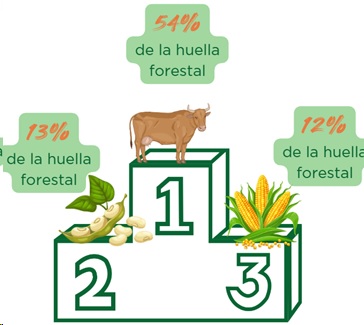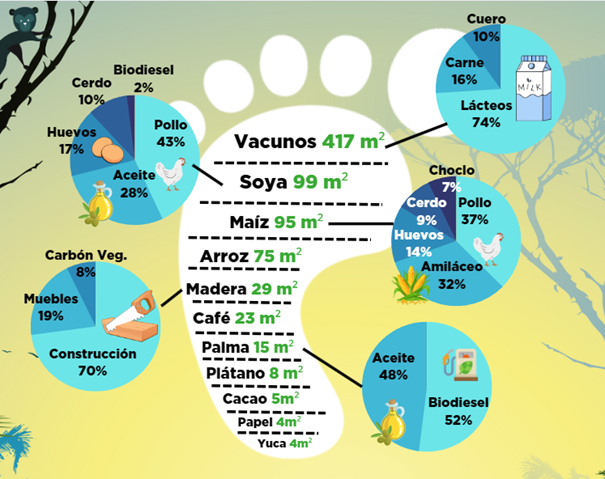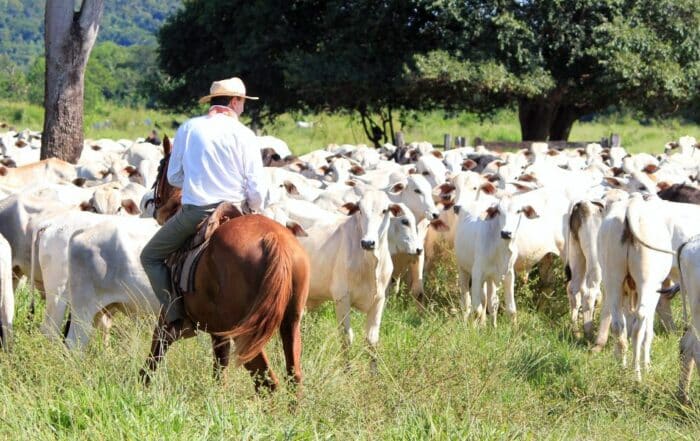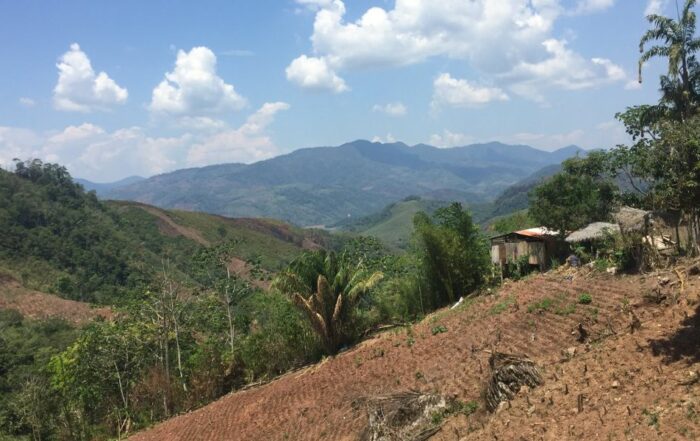Envol Vert launches the Forest Footprint of Peruvians, which seeks to expose the relationship between national consumption and deforested forest area. It amounts to 773 m², which is equivalent to 1.5 futsal pitch that an average Peruvian takes from the forests to meet their annual needs.
Thursday the 12th of october 2023, the official launch of the Peruvian Forest Footprint took place, at the Alliance Française in Lima. Envol Vert benefited from the participation of several key players in the development of this sustainable tool. Thus, a discussion on traceability was organized with members of organizations such as the Ministry of Environment (MINAM), Ministry of Agrarian Development (MIDAGRI), European Union in Peru, Food and Agriculture Organization of the United Nations (FAO) and French Agency for Development (AFD).
The Forest Footprint is a tool that aims to measure the impact of common consumer products on deforestation and degradation of natural forests, resulting from the deforestation caused by the purchase and production of certain food or basic products in a country. The Forest Footprint has been calculated for France, Colombia, and Peru, making it a novelty!
How was it calculated?
The Forest Footprint is a symbolic indicator that accounts for the pressure exerted by humans on forests through the production systems of food and non-food products. More specifically, it measures the land areas necessary to produce resources (raw materials) with a risk of deforestation consumed by an individual, a population, or an activity, taking into account the management of resources globally or specific to a country.
A technical committee has been set up with different institutions and organizations specializing in these issues :
- ONGs : WWF, DAR (Law, Environment and Natural Resources), SPDA (Peruvian Society of Environmental Law) and ACCA (Association for the Conservation of the Amazon Watershed);
- Ministries : MIDAGRI (Ministry of Agrarian Development and Irrigation) and MINAM (Ministry of Environment) ;
- International cooperation actors : AFD (French Alliance for Development) and GIZ (German Society for International Cooperation) ;
- the Center for International Forestry Research (CIFOR) and World Agroforestry (ICRAF).
The Forest Footprint as a tool to raise awareness
The Forest Footprint seeks to raise awareness among the public about the relationship between the consumption of common products and the impacts in terms of deforestation through a tool that simplifies the information about the complexity of deforestation processes. The Forest Footprint corresponds to the risk that an area is taken from forests to supply the consumption needs and lifestyle of an average Peruvian.
A striking 54% of the 773 m² Forest Footprint is a consequence of the consumption of meat and dairy products!
Often, we have false perceptions about the causes of deforestation, especially among citizens who tend to think that deforestation is related to “consuming too much paper” or “building furniture.” The Peruvian Forest Footprint, a tool that allows us to break these false beliefs, shows that 89% of the Peruvian consumer’s forest footprint is related to food products. Paper and furniture represent only 3% of the Forest Footprint, while 39% is attributed to dairy product consumption and 10% to chicken consumption.

Soybean represents the 2nd place, accounting for 13% of the Forest Footprint; mainly used as soybean tortas (cattle feed) and soybean oil ; and corn represents 12% of the Forest Footprint, due to the very high consumption of chicken (50 kg/year/person) and eggs. Corn and soybeans are mainly used as animal feed.
Other raw materials have less relevance, leather (shoes and leather goods) represents around 5% of the Forest Footprint, and construction timber accounts for just 2%. Additionally, apart from rice, it is noticeable that the products with the most significant impact on the Footprint are linked to animal product consumption.

Reducing one’s Forest Footprint is indeed possible.
Envol Vert has demonstrated that it is easy to lower your forest footprint by making small changes in consumption habits and lifestyles. Consumers can reduce their footprint by consuming fewer animal products ! Given the significant responsibility of meat (especially chicken), eggs, and dairy consumption, a conscientious vegetarian can reduce their forest footprint by 21%, while a vegan can reduce it by over 70%.
Important recommendations for different publics: consumers, government, and businesses:
Consumers
- Reduce consumption of dairy products and red and white meat products, replacing them with vegetable proteins (chickpeas, lentils, beans…): have at least 1 vegetarian lunch per week.
- Vary cooking oils (sunflower, olive…) to avoid palm and/or soybean oil.
- Replace white rice with brown rice to reduce portions since brown rice is more nutritious.
- Prioritize soft and/or shared mobility options.
- Be a responsible consumer in your purchases, avoid over-consumption and ephemeral trends, reuse, recycle and repair your products. This strengthens the local economy and your finances.
- Be a more demanding consumer: ask for information about traceability.
State / public policy
- Implementing a strong and unified traceability tool for agricultural products is essential in the fight against deforestation. SERNANP’s “Allies for Conservation” seal guarantees zero deforestation production.
- Support farmers and cooperatives in sustainable projects, inputs, technical assistance, to avoid burning, promote agroforestry and silvopastoralism. Support the improvement of yields of some raw materials (cattle).
- Calculate the Peruvian government’s Forest Footprint to influence public procurement.
Businesses / private sector
- Better production: increase livestock yields through silvopastoralism, especially in the Amazonian departments where the threat of deforestation is the greatest.
- Adopt strong traceability and zero deforestation policies with guidelines and rules that seek traceability in all production chains. This means dedicating human and financial resources.
- Develop a direct and local use of raw materials. This allows them to have better control over the inputs they buy, reducing the number of intermediaries. It also generates a fairer trade, improving the selling price to the producer.
- Avoid imports from countries with higher deforestation (such as soybeans in Bolivia).
To calculate your forest footprint: https://forest-footprint.org/quizz/
The Peruvian Forest Footprint was financed by the French Development Agency (AFD).
To learn more, download the Forest Footprint Peru Report.
Envol Vert launches the Forest Footprint of Peruvians, which seeks to expose the relationship between national consumption and deforested forest area. It amounts to 773 m², which is equivalent to 1.5 futsal pitch that an average Peruvian takes from the forests to meet their annual needs.
Thursday the 12th of october 2023, the official launch of the Peruvian Forest Footprint took place, at the Alliance Française in Lima. Envol Vert benefited from the participation of several key players in the development of this sustainable tool. Thus, a discussion on traceability was organized with members of organizations such as the Ministry of Environment (MINAM), Ministry of Agrarian Development (MIDAGRI), European Union in Peru, Food and Agriculture Organization of the United Nations (FAO) and French Agency for Development (AFD).
The Forest Footprint is a tool that aims to measure the impact of common consumer products on deforestation and degradation of natural forests, resulting from the deforestation caused by the purchase and production of certain food or basic products in a country. The Forest Footprint has been calculated for France, Colombia, and Peru, making it a novelty!
How was it calculated?
The Forest Footprint is a symbolic indicator that accounts for the pressure exerted by humans on forests through the production systems of food and non-food products. More specifically, it measures the land areas necessary to produce resources (raw materials) with a risk of deforestation consumed by an individual, a population, or an activity, taking into account the management of resources globally or specific to a country.
A technical committee has been set up with different institutions and organizations specializing in these issues :
- ONGs : WWF, DAR (Law, Environment and Natural Resources), SPDA (Peruvian Society of Environmental Law) and ACCA (Association for the Conservation of the Amazon Watershed);
- Ministries : MIDAGRI (Ministry of Agrarian Development and Irrigation) and MINAM (Ministry of Environment) ;
- International cooperation actors : AFD (French Alliance for Development) and GIZ (German Society for International Cooperation) ;
- the Center for International Forestry Research (CIFOR) and World Agroforestry (ICRAF).
The Forest Footprint as a tool to raise awareness
The Forest Footprint seeks to raise awareness among the public about the relationship between the consumption of common products and the impacts in terms of deforestation through a tool that simplifies the information about the complexity of deforestation processes. The Forest Footprint corresponds to the risk that an area is taken from forests to supply the consumption needs and lifestyle of an average Peruvian.
A striking 54% of the 773 m² Forest Footprint is a consequence of the consumption of meat and dairy products!
Often, we have false perceptions about the causes of deforestation, especially among citizens who tend to think that deforestation is related to “consuming too much paper” or “building furniture.” The Peruvian Forest Footprint, a tool that allows us to break these false beliefs, shows that 89% of the Peruvian consumer’s forest footprint is related to food products. Paper and furniture represent only 3% of the Forest Footprint, while 39% is attributed to dairy product consumption and 10% to chicken consumption.

Soybean represents the 2nd place, accounting for 13% of the Forest Footprint; mainly used as soybean tortas (cattle feed) and soybean oil ; and corn represents 12% of the Forest Footprint, due to the very high consumption of chicken (50 kg/year/person) and eggs. Corn and soybeans are mainly used as animal feed.
Other raw materials have less relevance, leather (shoes and leather goods) represents around 5% of the Forest Footprint, and construction timber accounts for just 2%. Additionally, apart from rice, it is noticeable that the products with the most significant impact on the Footprint are linked to animal product consumption.

Reducing one’s Forest Footprint is indeed possible.
Envol Vert has demonstrated that it is easy to lower your forest footprint by making small changes in consumption habits and lifestyles. Consumers can reduce their footprint by consuming fewer animal products ! Given the significant responsibility of meat (especially chicken), eggs, and dairy consumption, a conscientious vegetarian can reduce their forest footprint by 21%, while a vegan can reduce it by over 70%.
Important recommendations for different publics: consumers, government, and businesses:
Consumers
- Reduce consumption of dairy products and red and white meat products, replacing them with vegetable proteins (chickpeas, lentils, beans…): have at least 1 vegetarian lunch per week.
- Vary cooking oils (sunflower, olive…) to avoid palm and/or soybean oil.
- Replace white rice with brown rice to reduce portions since brown rice is more nutritious.
- Prioritize soft and/or shared mobility options.
- Be a responsible consumer in your purchases, avoid over-consumption and ephemeral trends, reuse, recycle and repair your products. This strengthens the local economy and your finances.
- Be a more demanding consumer: ask for information about traceability.
State / public policy
- Implementing a strong and unified traceability tool for agricultural products is essential in the fight against deforestation. SERNANP’s “Allies for Conservation” seal guarantees zero deforestation production.
- Support farmers and cooperatives in sustainable projects, inputs, technical assistance, to avoid burning, promote agroforestry and silvopastoralism. Support the improvement of yields of some raw materials (cattle).
- Calculate the Peruvian government’s Forest Footprint to influence public procurement.
Businesses / private sector
- Better production: increase livestock yields through silvopastoralism, especially in the Amazonian departments where the threat of deforestation is the greatest.
- Adopt strong traceability and zero deforestation policies with guidelines and rules that seek traceability in all production chains. This means dedicating human and financial resources.
- Develop a direct and local use of raw materials. This allows them to have better control over the inputs they buy, reducing the number of intermediaries. It also generates a fairer trade, improving the selling price to the producer.
- Avoid imports from countries with higher deforestation (such as soybeans in Bolivia).
To calculate your forest footprint: https://forest-footprint.org/quizz/
The Peruvian Forest Footprint was financed by the French Development Agency (AFD).
To learn more, download the Forest Footprint Peru Report.






